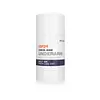What's inside
What's inside
 Key Ingredients
Key Ingredients

 Benefits
Benefits

 Concerns
Concerns

 Ingredients Side-by-side
Ingredients Side-by-side

Water
Skin ConditioningIsoamyl Laurate
EmollientStearyl Alcohol
EmollientHelianthus Annuus Seed Oil
EmollientCeteareth-20
CleansingGlycerin
HumectantZea Mays Starch
AbsorbentC12-15 Alkyl Benzoate
AntimicrobialOleyl Erucate
EmollientJojoba Esters
EmollientLactic Acid
BufferingSclerotium Gum
Emulsion StabilisingNiacinamide
SmoothingTocopheryl Acetate
AntioxidantButyrospermum Parkii Butter
Skin ConditioningZinc Neodecanoate
Isopropyl Myristate
EmollientParfum
MaskingPolyglyceryl-3 Caprate
EmulsifyingSodium Benzoate
MaskingEthylhexylglycerin
Skin ConditioningGlycine Soja Oil
EmollientBenzyl Alcohol
PerfumingWater, Isoamyl Laurate, Stearyl Alcohol, Helianthus Annuus Seed Oil, Ceteareth-20, Glycerin, Zea Mays Starch, C12-15 Alkyl Benzoate, Oleyl Erucate, Jojoba Esters, Lactic Acid, Sclerotium Gum, Niacinamide, Tocopheryl Acetate, Butyrospermum Parkii Butter, Zinc Neodecanoate, Isopropyl Myristate, Parfum, Polyglyceryl-3 Caprate, Sodium Benzoate, Ethylhexylglycerin, Glycine Soja Oil, Benzyl Alcohol
Aluminum Zirconium Tetrachlorohydrex Gly 20%
AstringentCyclopentasiloxane
EmollientStearyl Alcohol
EmollientPPG-14 Butyl Ether
Skin ConditioningDicaprylyl Carbonate
EmollientParfum
MaskingHydrogenated Castor Oil
EmollientIsopropyl Myristate
EmollientLauryl Methacrylate/Glycol Dimethacrylate Crosspolymer
PEG-8 Distearate
EmulsifyingSilica
AbrasivePropylene Glycol
HumectantEthylhexylglycerin
Skin ConditioningMaranta Arundinacea Root Extract
SmoothingCoconut Alkanes
EmollientCharcoal Powder
AbrasiveAlexidine Hydrochloride
Coco-Caprylate/Caprate
EmollientAluminum Zirconium Tetrachlorohydrex Gly 20%, Cyclopentasiloxane, Stearyl Alcohol, PPG-14 Butyl Ether, Dicaprylyl Carbonate, Parfum, Hydrogenated Castor Oil, Isopropyl Myristate, Lauryl Methacrylate/Glycol Dimethacrylate Crosspolymer, PEG-8 Distearate, Silica, Propylene Glycol, Ethylhexylglycerin, Maranta Arundinacea Root Extract, Coconut Alkanes, Charcoal Powder, Alexidine Hydrochloride, Coco-Caprylate/Caprate
Ingredients Explained
These ingredients are found in both products.
Ingredients higher up in an ingredient list are typically present in a larger amount.
Ethylhexylglycerin (we can't pronounce this either) is commonly used as a preservative and skin softener. It is derived from glyceryl.
You might see Ethylhexylglycerin often paired with other preservatives such as phenoxyethanol. Ethylhexylglycerin has been found to increase the effectiveness of these other preservatives.
Isopropyl Myristate is an emollient, thickening agent, and texture enhancer. It is created from isopropyl alcohol and myristic acid.
It is used to help other ingredients be better absorbed. It is also an emollient and may help soften and hydrate the skin.
The comedogenic rating of this ingredient depends on the concentration. Lower amounts results in a lower rating.
Isopropyl Myristate may not be fungal acne safe. It can potentially worsen acne prone skin.
Learn more about Isopropyl MyristateParfum is a catch-all term for an ingredient or more that is used to give a scent to products.
Also called "fragrance", this ingredient can be a blend of hundreds of chemicals or plant oils. This means every product with "fragrance" or "parfum" in the ingredients list is a different mixture.
For instance, Habanolide is a proprietary trade name for a specific aroma chemical. When used as a fragrance ingredient in cosmetics, most aroma chemicals fall under the broad labeling category of “FRAGRANCE” or “PARFUM” according to EU and US regulations.
The term 'parfum' or 'fragrance' is not regulated in many countries. In many cases, it is up to the brand to define this term.
For instance, many brands choose to label themselves as "fragrance-free" because they are not using synthetic fragrances. However, their products may still contain ingredients such as essential oils that are considered a fragrance by INCI standards.
One example is Calendula flower extract. Calendula is an essential oil that still imparts a scent or 'fragrance'.
Depending on the blend, the ingredients in the mixture can cause allergies and sensitivities on the skin. Some ingredients that are known EU allergens include linalool and citronellol.
Parfum can also be used to mask or cover an unpleasant scent.
The bottom line is: not all fragrances/parfum/ingredients are created equally. If you are worried about fragrances, we recommend taking a closer look at an ingredient. And of course, we always recommend speaking with a professional.
Learn more about ParfumStearyl Alcohol is a type of fatty alcohol from stearic acid. It is a white, waxy compound used to emulsify ingredients.
Fatty Alcohols are most often used as an emollient or to thicken a product. Emollients help soothe and hydrate the skin by trapping moisture.
They are usually derived from natural fats and oils and therefore do not have the same drying or irritating effect as solvent alcohols. FDA allows products labeled "alcohol-free" to have fatty alcohols.
Learn more about Stearyl Alcohol